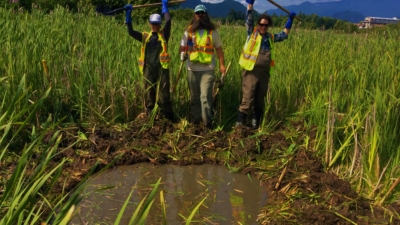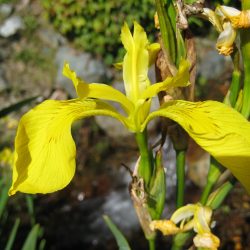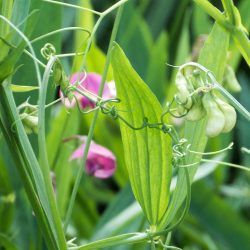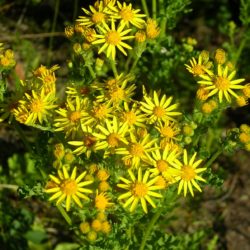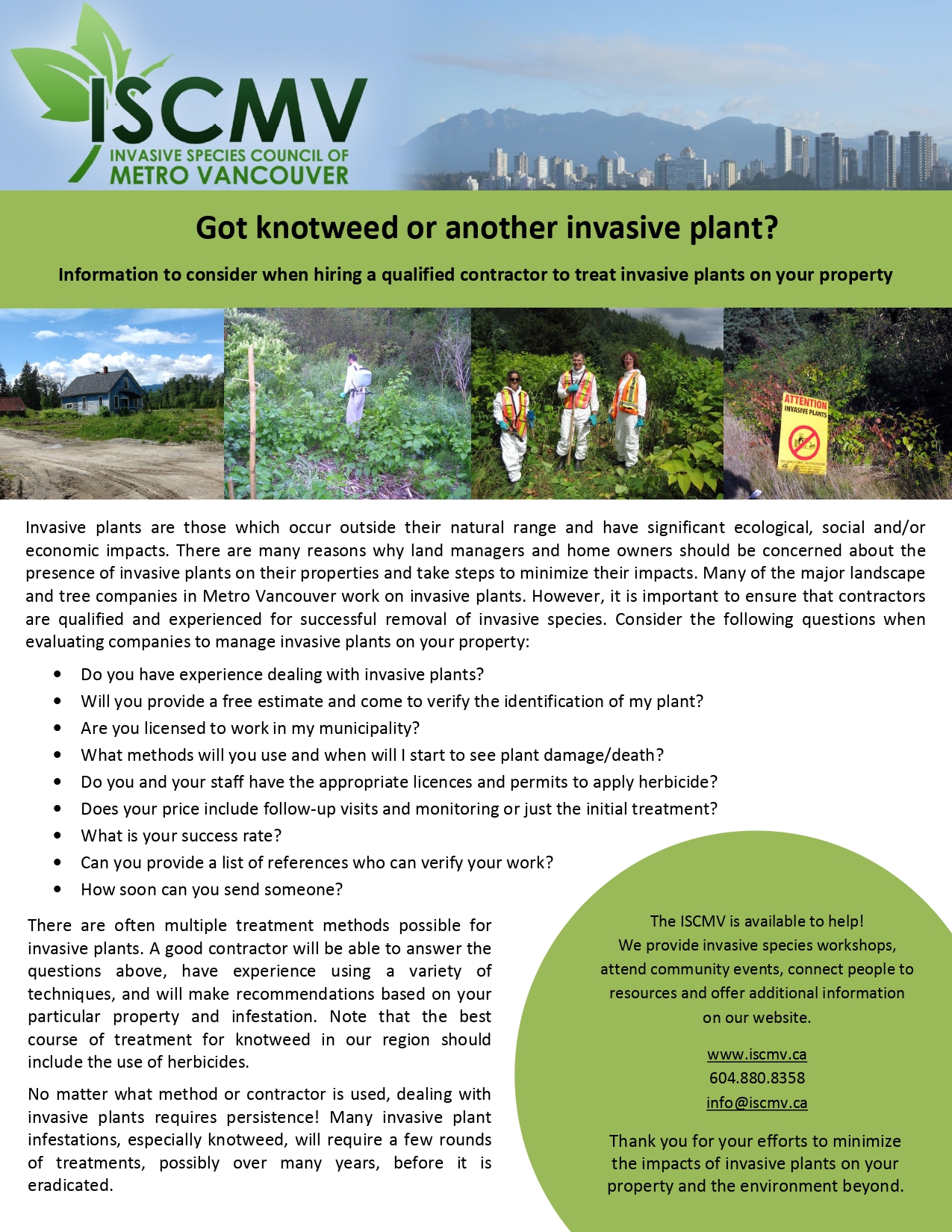Invasive Plant Management in Lions Bay
Are you curious about what SSISC is doing to protect the natural environment in Lions Bay ?
The purpose of this page is to inform Lions Bay residents of SSISC’s activities in the community. It provides information about the ‘what and the why’ of invasive species management activities, provides details on the species to be treated, and the methods employed to manage said species.
Each year, the SSISC is hired by various land owners and managers to carry out invasive species surveys, mapping, control and monitoring on both public and private lands from May to October. Most of our work is focused on invasive plants, but we also carry out surveys for invasive animals. More detail about our work in the Lions Bay area can be found below. You may see our Field Crews out and about this season, working hard to protect biodiversity in Lions Bay – give them a wave!
Our Education & Outreach Team will also be working behind the scenes to help raise awareness about invasive species and prevent new invaders from becoming established. There will be lots of new resources available online this season – watch this space, or sign up for our e-newsletter for updates.
If you have any questions or concerns about our work, please get in touch.
In Lions Bay, our target invasive species include:

- Displaces native plant communities
- Exudes allelopathic substances (biochemicals) that hinder the growth of other nearby plants
- Causes erosion and bank destabilization
- Disrupts freshwater food webs
- Can grow through small cracks in concrete, cement or drainage structures, putting public infrastructure in jeopardy
- Reduces sight lines when growing along roadways.
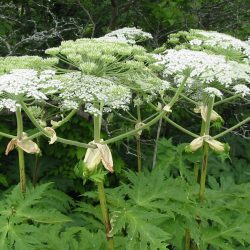
- Toxic sap can cause burns, blisters and painful dermatitis
- Exposure of sap to eyes may also cause temporary or permanent blindness
- Highly competitive plant due to its vigorous growth early on in the season, its tolerance to shade and seasonal flooding
- Able to co-exist with other aggressive growers
- Increases erosion hazards due to characteristically shallow roots

- All parts of the Spurge Laurel plant are highly toxic to humans, including berries, leaves, stem, bark and sap.
- Outcompetes native plants due to rapid spread (up to 5.5 m per season for a single plant) and dense patches.
- Blocks sunlight and competes with native plants for water and nutrients
- Especially problematic in riparian areas.
- While decaying, may release toxic chemicals that inhibit germination of other plant species.
- Poses a threat to native ecosystems, including Douglas fir forests and Garry oak woodlands.
Frequently Asked Questions
How does SSISC control invasive plants?
We use one or more of the following control methods to manage invasive plant infestations: mechanical, chemical and/or biological control.
- Mechanical control means physically removing plants from the environment. This can be done by cutting, digging, hand-pulling, cultivating, burning, girdling, smothering, etc. Depending on the specific method used, mechanical control can be done by hand or using hand tools, machinery or other equipment.
- Mechanical control usually requires multiple repeated removals.
- The method chosen depends on the species’ biology. For instance, for some species we may have to remove all plant parts (including the roots) to ensure control, whereas for other species, repeated cutting may be sufficient.
- Timing is often essential to the success of mechanical control efforts. For species that can reproduce by seed, we must ensure that the treatment is completed before the plants go to seed, otherwise we risk spreading the seeds and creating new infestations.
- Chemical control implies the use of herbicides to control invasive plants.
- Extremely aggressive and destructive invasives, such as Japanese Knotweed, require chemical control as it is the only effective method of management and eradication.
- The use of herbicides is strictly regulated, as explained below.
- To learn more about the decision-making process related to chemical control, please review the Invasive Plant Management page.
- Biological control is the intentional manipulation of natural enemies by humans for the purpose of controlling pests like invasive species
- SSISC carries out monitoring for biological control agents, as part of the Province of BC’s Biocontrol Program.
- The objective of this program is to reduce invasive plant populations to ecologically and environmentally acceptable levels, and to prevent invasive plants from spreading to new areas. Biocontrol is part of an integrated pest management approach.
- It is worth noting that biological control alone will never eradicate an invasive plant; rather, the goal is to suppress its population to allow the native plant community to regain vigour. Still, as the biocontrol agent’s population increases or decreases, the targeted plant species’ population will follow due to the increased or diminished supply of food, or conversely, feeding pressure.
The specific control method or combination of methods used is determined by the land manager, in collaboration with SSISC, and considers factors including site-specific characteristics, plant biology, weather conditions, time of year, and the priority level of the specific invasive.
Why does SSISC use herbicide at some sites instead of manual removal methods?
- Invasive Plant management requires an integrated approach, with herbicides being just one tool in the toolbox.
- We use all tools available to control invasive plants based on effectiveness, economics and environmental stewardship.
- We follow species-specific best management practices which may involve mechanical or manual removals, cultural control, biocontrol, herbicide treatments, or some combination of these methods.
- Herbicide is used at a site when it is deemed to be the best approach for a species, at a given site. Herbicide is used when manual removal, cultural control and/or biocontrol, are ineffective, and/or not feasible.
- The decision about which method to use, depends on the species, site conditions, environmental variables, weather conditions, timing of treatment and considerations of the land owner/ manager.
What is a herbicide?
- Herbicides are a type of pesticide.
- Herbicides are used to control/kill plants. The mode of action is specific to plants.
- Not all pesticides are herbicides. Other groups of pesticides include insecticides and fungicides.
What laws is SSISC subject to?
The SSISC conducts herbicide treatments in accordance with all local, provincial, and federal laws:
- The BC Integrated Pest Management Act and Regulation spells out all the rules and regulations pertaining to the use of herbicides in BC, including distances to water, weather and wind conditions within which plants can be sprayed, transportation of herbicides and many other considerations for safe use of pesticides. We take great care to abide by these and many other regulations.
- For work on provincial crown land, we work under the South Coastal Mainland Pest Management Plan.
- For work on municipal crown lands, first nations reserve lands and private lands, we work under fee-for-service agreements.
- SSISC only uses herbicide products that have been approved for use by Health Canada. More information about approved herbicides can be found here on the Health Canada Consumer Product Safety page
- Herbicide product labels denote the specifics of how herbicides are permitted to be used. The SSISC takes great care to ensure the label and the manufacturer’s recommendations are followed.
What is the process of herbicide application like?
Our staff and contractors typically conduct either directed sprays using a hand-gun or back pack sprayer, spot treatments, wiper treatments (wicking), or stem injection. Our staff and contractors do not conduct large, broadcast spray or boom spray operations.
The exact application method is tailored to suit the target species. You can learn about how we ‘knock and spray’ knotweed here.
What are your qualifications?
The SSISC holds a valid Pesticide Use Licence, and has 10 years of experience controlling invasive plants in the Sea to Sky Region.
All SSISC staff or contractors working with herbicide, hold a valid BC Pesticide Applicator’s Certificate, or Assistant Applicator’s Certificate. Click here for more information about Pesticide Applicator Certification in BC.
How do you decide which sites and species to treat?
Across the whole region, there are over 200 species on our species list. Since we can’t tend to every species due to staffing, budgeting and time constraints, we have to prioritize which species we work on, and which sites are most important to control.
This prioritization exercise is carried out annually, in collaboration with partners and funders, through the SSISC Partner Planning Session, held every spring. You can learn more about SSISC’s regional strategy and priority species list here.
Disposal

If you remove any invasive plants from your yard or your neighbourhood (thank you!), please remember to:
- Separate invasive plant material from yard waste
- Place invasive plant material in a bag, or on a tarp, & seal it
- Take to the transfer station/landfill
- DO NOT COMPOST!
Please note – according to the Village of Lions Bay, invasive species must be disposed of by taking them to the North Vancouver Transfer Station, not by placing them curbside for pickup.
You can learn more about the Village of Lions Bay Soil Deposit, Soil Removal and Land Alteration Bylaw here.
You can read more about how to dispose of invasive species on this page.
Get Involved!
Invader Eliminator Kit
Do you want to remove invasive species but don’t know where to start?
The Invader Eliminator kit might be able to help! It’s a free online toolkit with everything you need to eliminate invasive species in your neighborhood. There are separate toolkits for Squamish, Whistler & Pemberton – check out the kit for whichever area is closest to you!
Are you ready to eliminate invaders?

Invasives Scavenger Hunt
Do you have children who are aching to play outside?
The Invasives Scavenger Hunt is a great way for children 7-12 to get to know their environment better, sharpen their plant identification skills and generally have fun playing detectives!
Are you ready to play detective? Get started today!

For more information
This factsheet was published by the Invasive Species of Metro Vancouver to offer residents guidance when seeking the help of qualified, experienced contractors for invasive species control.
This document outlines the organization’s goals in fulfilling the mission of minimizing the threat of invasive species that impact on the environment, the economy and human health in the Sea to Sky corridor.
This document lists all the plant species that SSISC has identified as invasive in the Sea to Sky corridor, along with their level of priority.
More information about each management category can be found here.
Lions Bay is located in Invasive Species Management Area (ISMA) 1.
The Use of Pesticides in Invasive Species Management: A Position Statement of the North American Invasive Species Management Association
SSISC is a member of the North American Invasive Species Management Association (NAISMA). In this white paper, NAISMA outlines its position that when prevention measures fail, the presence of invasive species may require management action to prevent further ecological destruction and range expansion. The proper use of pesticides as part of an integrated pest management (IPM) approach falls in line with this desire to prevent further damage to the environment, the economy and human health.


